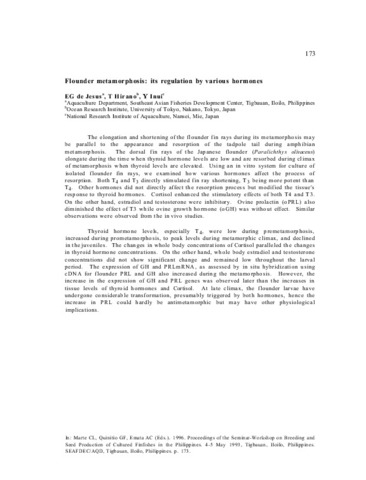Flounder metamorphosis: its regulation by various hormones
- Global styles
- MLA
- Vancouver
- Elsevier - Harvard
- APA
- Help
Share
抄録
The elongation and shortening of the flounder fin rays during its metamorphosis may be parallel to the appearance and resorption of the tadpole tail during amphibian metamorphosis. The dorsal fin rays of the Japanese flounder (Paralichthys olivaceus) elongate during the time when thyroid hormone levels are low and are resorbed during climax of metamorphosis when thyroid levels are elevated. Using an in vitro system for culture of isolated flounder fin rays, we examined how various hormones affect the process of resorption. Both T4 and T3 directly stimulated fin ray shortening, T3 being more potent than T4. Other hormones did not directly affect the resorption process but modified the tissue's response to thyroid hormones. Cortisol enhanced the stimulatory effects of both T4 and T3. On the other hand, estradiol and testosterone were inhibitory. Ovine prolactin (oPRL) also diminished the effect of T3 while ovine growth hormone (oGH) was without effect. Similar observations were observed from the in vivo studies.
Thyroid hormone levels, especially T4, were low during premetamorphosis, increased during prometamorphosis, to peak levels during metamorphic climax, and declined in the juveniles. The changes in whole body concentrations of Cortisol paralleled the changes in thyroid hormone concentrations. On the other hand, whole body estradiol and testosterone concentrations did not show significant change and remained low throughout the larval period. The expression of GH and PRLmRNA, as assessed by in situ hybridization using cDNA for flounder PRL and GH also increased during the metamorphosis. However, the increase in the expression of GH and PRL genes was observed later than the increases in tissue levels of thyroid hormones and Cortisol. At late climax, the flounder larvae have undergone considerable transformation, presumably triggered by both hormones, hence the increase in PRL could hardly be antimetamorphic but may have other physiological implications.
Suggested Citation
de Jesus, E. G., Hirano, T., Inui, Y. (1996). Flounder metamorphosis: its regulation by various hormones. In C. L. Marte, G. F. Quinitio, & A. C. Emata (Eds.), Proceedings of the Seminar-Workshop on Breeding and Seed Production of Cultured Finfishes in the Philippines, Tigbauan, Iloilo, Philippines, 4-5 May 1993 (pp. 173). Tigbauan, Iloilo, Philippines: Aquaculture Department, Southeast Asian Fisheries Development Center.
Type
Conference paperISBN
9718511326



